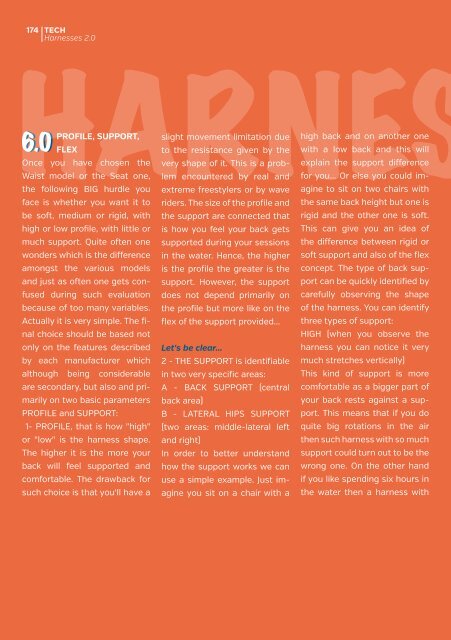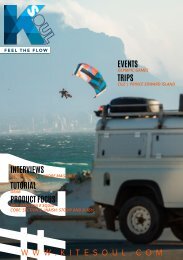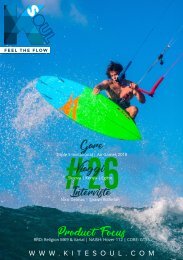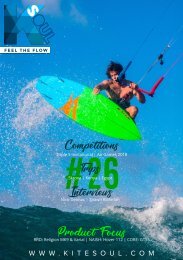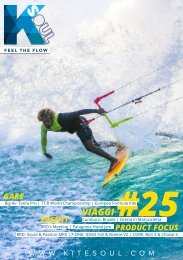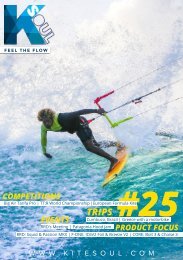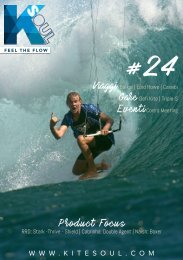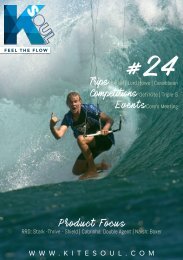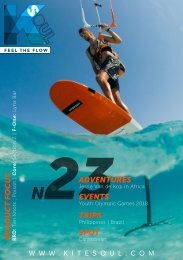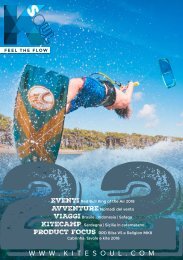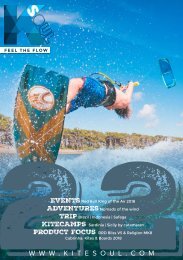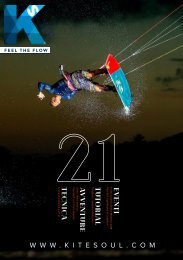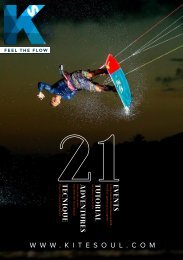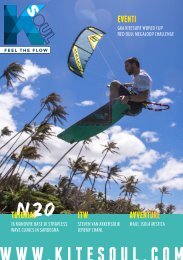Kitesoul Magazine #10 English Edition
Riders columns: Colleen Carroll, Jasse Richman; Events: World Snowkite Contest preview, Blue Palawan Open; ITW: Liam Whaley; Story: Patri MacLaughlin; Trip: Mozambico, Artic Adventure;Tech: Harnesses, Fins; Tutorial: Freestyle moves, Foiloboard, Wave.
Riders columns: Colleen Carroll, Jasse Richman; Events: World Snowkite Contest preview, Blue Palawan Open; ITW: Liam Whaley; Story: Patri MacLaughlin; Trip: Mozambico, Artic Adventure;Tech: Harnesses, Fins; Tutorial: Freestyle moves, Foiloboard, Wave.
Create successful ePaper yourself
Turn your PDF publications into a flip-book with our unique Google optimized e-Paper software.
174<br />
TECH<br />
Harnesses 2.0<br />
PROFILE, SUPPORT,<br />
FLEX<br />
Once you have chosen the<br />
Waist model or the Seat one,<br />
the following BIG hurdle you<br />
face is whether you want it to<br />
be soft, medium or rigid, with<br />
high or low profile, with little or<br />
much support. Quite often one<br />
wonders which is the difference<br />
amongst the various models<br />
and just as often one gets confused<br />
during such evaluation<br />
because of too many variables.<br />
Actually it is very simple. The final<br />
choice should be based not<br />
only on the features described<br />
by each manufacturer which<br />
although being considerable<br />
are secondary, but also and primarily<br />
on two basic parameters<br />
PROFILE and SUPPORT:<br />
1- PROFILE, that is how "high"<br />
or "low" is the harness shape.<br />
The higher it is the more your<br />
back will feel supported and<br />
comfortable. The drawback for<br />
such choice is that you'll have a<br />
slight movement limitation due<br />
to the resistance given by the<br />
very shape of it. This is a problem<br />
encountered by real and<br />
extreme freestylers or by wave<br />
riders. The size of the profile and<br />
the support are connected that<br />
is how you feel your back gets<br />
supported during your sessions<br />
in the water. Hence, the higher<br />
is the profile the greater is the<br />
support. However, the support<br />
does not depend primarily on<br />
the profile but more like on the<br />
flex of the support provided...<br />
Let's be clear...<br />
2 - THE SUPPORT is identifiable<br />
in two very specific areas:<br />
A - BACK SUPPORT (central<br />
back area)<br />
B - LATERAL HIPS SUPPORT<br />
(two areas: middle-lateral left<br />
and right)<br />
In order to better understand<br />
how the support works we can<br />
use a simple example. Just imagine<br />
you sit on a chair with a<br />
high back and on another one<br />
with a low back and this will<br />
explain the support difference<br />
for you... Or else you could imagine<br />
to sit on two chairs with<br />
the same back height but one is<br />
rigid and the other one is soft.<br />
This can give you an idea of<br />
the difference between rigid or<br />
soft support and also of the flex<br />
concept. The type of back support<br />
can be quickly identified by<br />
carefully observing the shape<br />
of the harness. You can identify<br />
three types of support:<br />
HIGH (when you observe the<br />
harness you can notice it very<br />
much stretches vertically)<br />
This kind of support is more<br />
comfortable as a bigger part of<br />
your back rests against a support.<br />
This means that if you do<br />
quite big rotations in the air<br />
then such harness with so much<br />
support could turn out to be the<br />
wrong one. On the other hand<br />
if you like spending six hours in<br />
the water then a harness with


